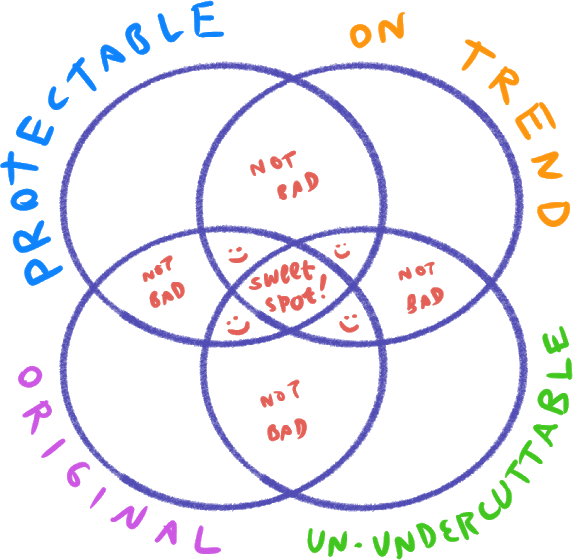Guest Post from Michael Essek: What Kind of Designs Should You Create?
Here at TeePublic, we've been fans of Michael Essek's Print-on-Demand tips for a while, so we're pumped to be running another entry in conjunction with him today. (Be sure to check out his previous blog entries on TeePublic’s blog here!) Like what you see? There's more where that came from on his website, so do check it out! With no further ado...take it away, Michael!
---
What Kind of Designs Should You Create? (Part 1)
One of the biggest problems as an independent T-Shirt designer is knowing what to focus on.
You don’t have a boss telling you what to create, or a client with a design brief.
Instead, you have to make your own decisions about what to create (and when).
- Should you create designs about the latest viral trend?
- Should you try to design for ‘evergreen niches’?
- Or should you try to do something completely ‘original’? (and what does that even mean anyway?)
Unfortunately, there’s no single answer to this problem.
What you should work on next will depend on what stage you are at, what your goals are, and what kind of business you are trying to build.
BUT - if you’re like me, and you’re interested in building something that stands the test of time - and creating designs that make more money for you next month than they do this month - I have some thoughts.
In fact, I have condensed my thoughts into a diagram, and here it is:
This is my ‘what designs you should create’ diagram.
What this means is that the ‘ideal’ design - the one you should prioritise above all else - should be:
- Protectable
- Original
- On Trend
- Un-Undercuttable (I made this word up)
If your design ticks two of the above boxes, that’s not bad.
If it does three - even better.
But the ‘sweet spot’ is where you cover all 4 bases.
---
I’ll dive into all of these features, but today, let’s focus on PROTECTABLE.
What does this mean?
Protectable means that the design you create will, at the very least ‘pass the bar’ of copyright protection.
In other words, it actually qualifies for copyright protection.
Examples of designs that probably won’t pass the bar of copyright protection:
- text-only designs
- text-only + ‘clip art’ (any art you didn’t create or commission)
- just some clip art or graphic that you didn’t create, and didn’t modify in any way
- super simple graphics, basic shapes, lines, etc. - that anyone could create in seconds, or that are default shapes included in design software.
Examples of designs that would pass the bar of copyright protection:
- original artwork that has clearly taken time and effort to produce
- hand-drawn or handwritten fonts and text
- if a relatively simple design, then at least the concept or idea is original, and some thought and time has gone into arranging the elements
If that seems difficult to grasp, here’s a short cut.
Ask this question:
If someone sees my design and recreates it, will it be obvious from their recreation that they have seen mine first?
If the answer is yes, you should be good.
If the answer is no, then it’s possible your design is not protectable.
For example - if you see two different text-only designs that both say “I LOVE MY DOG” - then it won’t be at all obvious that one design ‘copied’ the other.
“I LOVE MY DOG” is a generic statement, and even if you could prove that you created yours first - it still doesn’t follow that the other person copied you. They may have just had the same idea as you. They didn’t need to see your design to create theirs.
Whereas if you create a quality illustration of your dog, and you hand-letter the text above and below the illustration in a circular layout, using 3 different colours in the design and including some original floral graphics in the background - then there’s no way that someone could ‘accidentally’ recreate that.
If they use the same layout, the same copy, a similar font, similar colours, similar illustrative style - then anyone who sees them side by side must conclude that one has copied the other.
And this is what I mean by PROTECTABLE.
You want to create work that you can defend because it protects you from infringement; whether that’s copycats online, or nationwide brands that steal and imitate your work.
At a basic level, it means that if your design ‘takes off’ and starts to sell well, you can confidently deal with any infringers.
And in the long run, it means you reap the rewards of your hard work - whether that means getting the royalties you deserve from online channels - or receiving damages from a company that ripped you off.
That’s the real reason it matters: in the long run, you want to have a portfolio of work that is actually worth something out there in the real world (stuff that anyone can throw together in a couple of minutes is generally not worth a lot.)
This is not to say you should never create simple, basic, or text-only designs - sometimes there’s a time and a place for it, or it happens to be what the market wants.
But if you’re trying to decide on what to focus on for long-term growth: un-protectable work is not going to do that.
Designs that take some time, effort, and originality are what strong, successful, and long-lasting design brands and art-licensing businesses are built on - so go do that!
Until next time,
Michael Essek
Website
Twitter
Facebook
---
Thanks for reading and of course, a big thank you to Michael Essek for sharing his expertise with all of us once again! Michael recently published a new guide to selling on Teepublic, so be sure to check that out!
And be sure to check out Michael’s previous blog entry for TeePublic on A Technique for Producing Ideas.
Has this blog entry inspired you to try new things?
UPLOAD NOW









